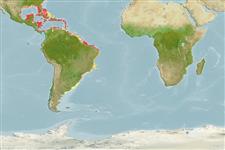>
Eupercaria/misc (Various families in series Eupercaria) >
Scaridae (Parrotfishes) > Scarinae
Etymology: Scarus: Greek, skaros = a fish described by anciente writers as a parrot fish; 1601 (Ref. 45335).
More on author: Cuvier.
Environment: milieu / climate zone / depth range / distribution range
Ecología
marino asociado a arrecife; rango de profundidad 3 - 25 m (Ref. 9710). Subtropical; 33°N - 41°S, 100°W - 29°W
Western Atlantic: Bermuda, Florida (USA), and the Bahamas to Argentina; absent in the northern Gulf of Mexico.
Tamaño / Peso / Age
Maturity: Lm ? range ? - ? cm
Max length : 120 cm TL macho / no sexado; (Ref. 7251); common length : 70.0 cm TL macho / no sexado; (Ref. 3802); peso máximo publicado: 20.0 kg (Ref. 9710)
Espinas dorsales (total): 9; Radios blandos dorsales (total): 10; Espinas anales 3; Radios blandos anales: 9. Fins dull orange with tongues of green extending into the dorsal and anal; margins of median fins blue; dental plates blue-green. There appears to be no obvious difference in color with sex (Ref. 13442).
Inhabits coral reefs. Young are commonly found in mangrove areas. Feeds mainly on benthic algae (Ref. 3802). Known to have a home cave to which it retires at night or when danger threatens; makes use of the sun as an aid to locating the cave.
Life cycle and mating behavior
Madurez | Reproducción | Puesta | Huevos | Fecundidad | Larva
Oviparous, distinct pairing during breeding (Ref. 205).
Parenti, P. and J.E. Randall, 2000. An annotated checklist of the species of the labroid fish families Labridae and Scaridae. Ichthyol. Bull. J.L.B. Smith Inst. Ichthyol. (68):1-97. (Ref. 35918)
IUCN Red List Status (Ref. 130435)
Threat to humans
Reports of ciguatera poisoning (Ref. 30911)
Human uses
Pesquerías: escaso valor comercial; Acuario: Comercial
Más información
ReferenciasAcuiculturaPerfil de acuiculturaRazasGenéticaElectrophoresesheritabilidadEnfermedadesProcesamientoNutrientsMass conversion
Herramientas
Special reports
Download XML
Fuentes de Internet
Estimates based on models
Preferred temperature (Ref.
123201): 23.7 - 28.1, mean 27.3 °C (based on 769 cells).
Phylogenetic diversity index (Ref.
82804): PD
50 = 0.5000 [Uniqueness, from 0.5 = low to 2.0 = high].
Bayesian length-weight: a=0.01349 (0.00814 - 0.02236), b=3.02 (2.88 - 3.16), in cm total length, based on LWR estimates for this species & Genus-body shape (Ref.
93245).
Nivel trófico (Ref.
69278): 2.0 ±0.0 se; based on diet studies.
Generation time: 3.7 ( na - na) years. Estimated as median ln(3)/K based on 1
growth studies.
Resiliencia (Ref.
120179): Medio, población duplicada en un tiempo mínimo de 1.4-4.4 años (Preliminary K or Fecundity.).
Fishing Vulnerability (Ref.
59153): Moderate vulnerability (42 of 100).
Nutrients (Ref.
124155): Calcium = 14.2 [7.6, 22.9] mg/100g; Iron = 0.608 [0.374, 1.000] mg/100g; Protein = 19.5 [17.4, 21.4] %; Omega3 = 0.11 [0.06, 0.20] g/100g; Selenium = 11.1 [5.5, 21.4] μg/100g; VitaminA = 16.8 [4.2, 63.6] μg/100g; Zinc = 1.1 [0.8, 1.6] mg/100g (wet weight);
